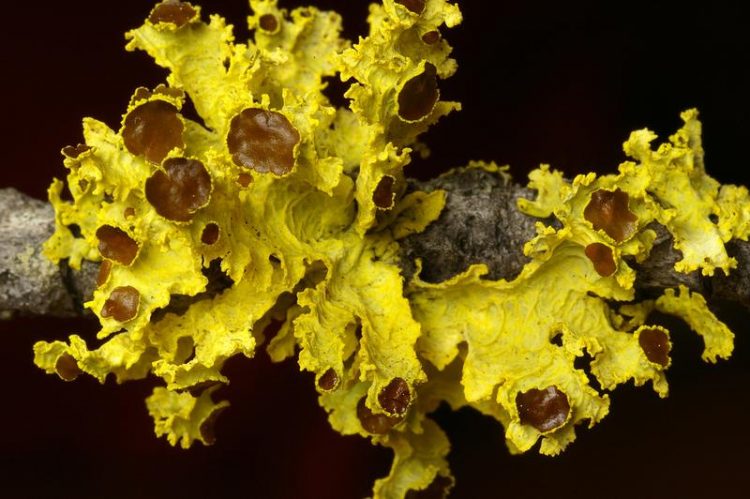University of Graz researchers challenge 140-year-old paradigm of lichen symbiosis

The lichen Vulpicida canadensis is common on tree barks in Northern America. As scientists have found out, it consists of an alga and two fungi. Tim Wheeler/timwheelerphotography.com
Lichens, a mutually helpful relationship between an alga and a fungus, have long been a classic example of symbiosis. Now, that well-known dualistic relationship is being challenged. Together with colleagues from the USA and Sweden, researchers of the University of Graz have shown that some of the world's most common lichen species are actually composed of not one but two fungi. These findings are published online on July 22nd and will be the cover story in the July 29th issue of the journal Science.
Thanks to recent advances in genomic sequencing, Toby Spribille, the project leader and a postdoctoral researcher working with Helmut Mayrhofer at the Institute of Plant Sciences in Graz, showed that many lichens contain a previously unknown second fungus, identified as a form of yeast. He discovered the new fungus when he set out to answer why one of two closely related lichen species, common in the western United States, contains substances toxic to mammals while the other does not.
Using short pieces of “barcode” DNA they obtained from their genome sequencing, the researchers began to check other lichens from all over the world for the presence of the yeast. It turned out that the second fungus was everywhere: the research team found it in common lichens from Antarctica to Japan, and from South America to the highlands of Ethiopia.
The fungus had been overlooked by over one hundred years of microscopic studies. Spribille teamed up with researchers in Sweden and the Microscopy Core Facility at the University of Graz Institute for Molecular Biosciences to make the yeasts visible using fluorescent labeling techniques.
“This is a pretty fundamental shake-up of what we thought we knew about the lichen symbiosis,” says Spribille. “It's easy to see how it was overlooked. But now it really does force a reassessment of basic assumptions about how lichens are formed and who does what in the symbiosis.”
The research team now hope to gain a better understanding of the interactions of the two fungi as a way to understand how symbiosis works. “Basically in symbiosis two organisms get past the urge to compete or repel each other and together form something that wasn't there before”, Spribille explains. “Figuring out how they do this could give us fundamental insight into how species cooperate at a cellular level”.
The Institute of Plant Sciences of the University of Graz is a leading centre in the lichen symbiosis research worldwide. The analyses were realised together with the Institute of Molecular Biosciences and were financed by the Austrian Science Fund and through collaboration with the University of Montana, Uppsala University and Purdue University.
Publication:
Toby Spribille, Veera Tuovinen, Philipp Resl, Dan Vanderpool, Heimo Wolinski, M. Catherine Aime, Kevin Schneider, Edith Stabentheiner, Merje Toome-Heller, Göran Thor, Helmut Mayrhofer, Hanna Johannesson, John P. McCutcheon: „Basidiomycete yeasts in the cortex of ascomycete macrolichens” Science (online July 22, 2016).
Contact:
Dr. Toby Spribille
Institute of Plant Sciences of the University of Graz
Tel.: +43 (0) 660/839 2918
E-Mail: toby.spribille@mso.umt.edu
Media Contact
More Information:
http://www.uni-graz.atAll latest news from the category: Life Sciences and Chemistry
Articles and reports from the Life Sciences and chemistry area deal with applied and basic research into modern biology, chemistry and human medicine.
Valuable information can be found on a range of life sciences fields including bacteriology, biochemistry, bionics, bioinformatics, biophysics, biotechnology, genetics, geobotany, human biology, marine biology, microbiology, molecular biology, cellular biology, zoology, bioinorganic chemistry, microchemistry and environmental chemistry.
Newest articles

First-of-its-kind study uses remote sensing to monitor plastic debris in rivers and lakes
Remote sensing creates a cost-effective solution to monitoring plastic pollution. A first-of-its-kind study from researchers at the University of Minnesota Twin Cities shows how remote sensing can help monitor and…

Laser-based artificial neuron mimics nerve cell functions at lightning speed
With a processing speed a billion times faster than nature, chip-based laser neuron could help advance AI tasks such as pattern recognition and sequence prediction. Researchers have developed a laser-based…

Optimising the processing of plastic waste
Just one look in the yellow bin reveals a colourful jumble of different types of plastic. However, the purer and more uniform plastic waste is, the easier it is to…



